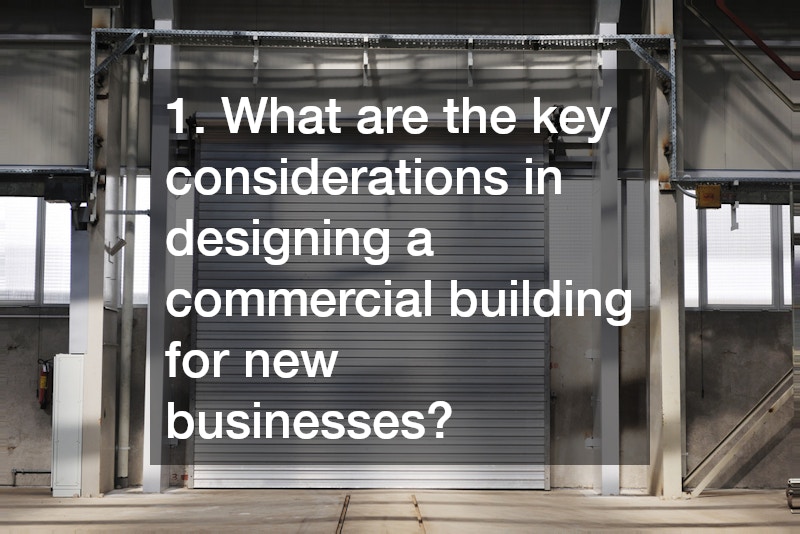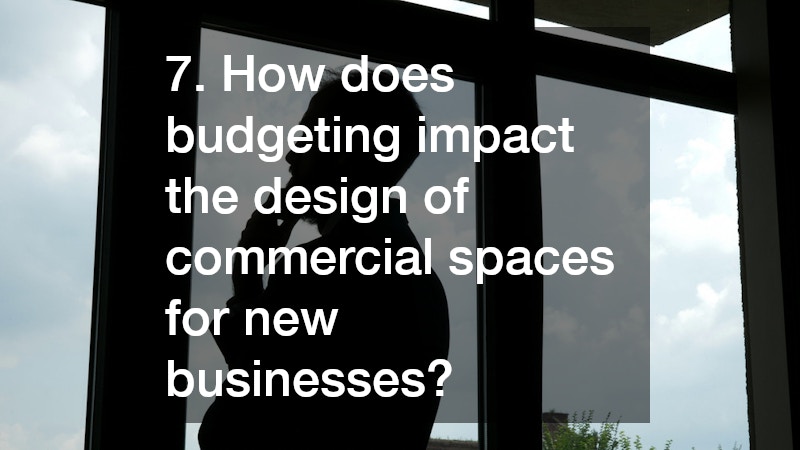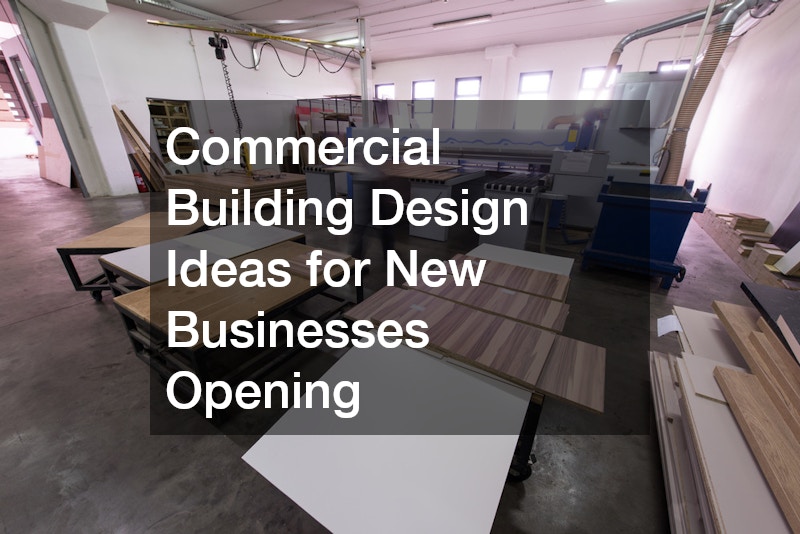The resurgence and vitality brought about by new businesses opening in communities cannot be overstated. New businesses inject freshness into the economy and provide novel services and employment opportunities. As these businesses open their doors, investing in intelligent and creative building design becomes crucial to their success. This article delves into various design ideas, focusing on function, sustainability, and branding, all crucial for establishing a thriving commercial space. From understanding key design considerations to exploring the latest trends, this comprehensive guide equips new business owners with insights and practical advice to navigate the complexities of designing a commercial building. By addressing common questions and challenges, this guide serves as a useful resource for making informed design decisions that will help new businesses opening their doors make a significant impact in their respective markets.
1. What are the key considerations in designing a commercial building for new businesses?

When new businesses are launching, the initial step in designing their building is to understand the specific requirements of their industry. These considerations cover how space will be utilized, employee needs, and customer interactions. Acknowledging these aspects helps in creating a space that is not only aesthetically pleasing but also functional. Additionally, employing business cyber security services during the design phase ensures sensitive data and operations are well-protected.
Another significant consideration is the selection of materials and finishes which directly impacts the interior and exterior aesthetics. Materials that ensure durability while maintaining visual appeal are essential. This selection process must account for the daily wear and tear faced by high-traffic areas. Furthermore, incorporating robust and secure commercial door companies‘ products guarantees safety and longevity.
Ensuring seamless accessibility is another priority in commercial design. New businesses should prioritize designs that accommodate disability access, including ramps, elevators, and accessible bathroom facilities. This focus not only complies with legal requirements but also enhances inclusivity. Integrating business cyber security services into a building’s design plan further contributes to a secure and future-proof commercial environment.
2. How can new businesses incorporate sustainability into their building design?
In today’s environmentally conscious landscape, sustainability is a key factor for new businesses opening to consider in their building design. Businesses should prioritize the use of sustainable materials such as recycled steel and bamboo flooring. These materials not only reduce environmental impact but can also be sourced from commercial door companies specializing in eco-friendly options.
Sustainability also involves energy-efficient designs. This can include the installation of solar panels and integrating advanced HVAC systems to minimize energy consumption. Implementing these elements from design to completion positions new businesses as environmentally responsible entities.
Another approach is using water-saving fixtures and systems throughout the building. These fixtures decrease water waste and can significantly reduce a business’s operating costs over time. Collaborations with companies focusing on sustainability, such as janitorial companies that use green cleaning products, can enhance a business’s eco-friendly strategy. Additionally, incorporating energy-efficient practices into maintenance, like taking advantage of commercial pressure washing environmentally safe methods, complements these design choices.
3. What are the latest design trends for new commercial spaces?
Design trends in commercial spaces are continuously evolving, reflecting the dynamic nature of customer expectations and technological advancements. One prominent trend is the integration of open-plan spaces that promote flexibility and transparency within the workspace. This trend facilitates communication and creates a dynamic work environment, making it ideal for new businesses opening their doors to innovation.
Another emerging trend is the adoption of biophilic design elements. Incorporating natural elements like indoor plants, natural lighting, and earthy materials can enhance employee well-being and productivity. This approach is complemented by services like janitorial companies that ensure these elements are well-maintained and clean.
Interactive and technology-enhanced spaces are also gaining traction. This includes the use of smart systems for lighting, climate control, and digital signage. By incorporating these trends, new commercial spaces can remain adaptable and relevant. Additionally, integrating commercial printing services with eco-friendly technology offers further innovative opportunities.
4. How to optimize space usability for new business facilities?

Optimizing space usability is crucial for the efficiency and functionality of a commercial facility, particularly for new businesses opening with specific spatial constraints. A well-thought-out layout maximizes available space, enhancing work flow and customer interaction points. For instance, adopting modular and multi-functional furniture can transform a small area into a versatile environment.
Space usability can be further optimized by appropriately utilizing vertical spaces. Installing shelving and smart storage solutions can expand a room’s functional capacity without compromising on design. Commercial printing services can help by providing sleek and customizable signage solutions for effective space branding.
Besides furniture and storage, optimizing space also involves smart partitioning using commercial awnings for both outdoors and indoor delineations. Proper partitioning allows different activities to coexist without interference, and ensures privacy where needed. In line with these efforts, new businesses should also consider collaborating with commercial door companies to enhance segregation between different functional areas.
5. What role does branding play in commercial building design for new businesses?
Branding is integral to the commercial building design process, offering businesses the opportunity to reinforce their brand identity through design elements. Aesthetics should echo a business’s values, mission, and industry positioning, thus creating a lasting impression on customers and employees alike. Employing corporate colors, logos, and themes throughout the space enhances cohesiveness.
For new businesses opening, branding also covers signage and logo displays, pivotal for recognition. Partnering with commercial printing services for high-quality materials ensures these elements are both visually appealing and durable. Similar importance must be given to the cleanliness and upkeep of these areas; professional commercial pressure washing services can maintain this appearance by keeping promotional materials clean and prominent.
Another branding strategy involves tailoring customer and employee interfaces to reflect the brand’s ethos. Incorporating personalized interior elements and facade designs amplifies brand presence. These designs support the company’s narrative, making new businesses stand out in competitive markets and fostering a more engaging customer experience.
6. How can new businesses effectively plan their commercial building layout?
Effective space planning starts with comprehending business operations and customer pathways. For new businesses opening their doors, it is critical to design layouts that support these flows with minimum obstruction. This meticulous planning ensures smooth navigation, encourages engagement, and minimizes congestion, ultimately enhancing both employee productivity and customer satisfaction. A well-organized layout can also strengthen brand perception by presenting a clean, intentional design that reflects professionalism and efficiency.
Space planning should also consider future growth and flexibility. Designing with adaptable spaces allows a business to accommodate evolving needs without major overhauls or costly renovations. For instance, movable partitions, modular furniture, and multipurpose areas make it easier to reconfigure layouts as the business expands or adjusts its services. This flexibility is key in a dynamic market, where staying agile and responsive to trends can determine long-term success. Future-proofing the design ensures that the business remains functional and relevant even as customer demands shift.
Furthermore, strategic use of commercial awnings can contribute to outdoor layout planning. Awnings offer additional sheltered areas for customer interaction, whether extending the waiting area, creating shaded seating, or highlighting a storefront display.
7. How does budgeting impact the design of commercial spaces for new businesses?

Budgeting is a critical component in any commercial design project, particularly for new businesses opening on a limited budget. Allocating resources wisely ensures that quality and durability are not compromised, even when financial constraints exist. Careful planning allows business owners to invest in design elements that provide the greatest return on investment, such as energy-efficient lighting, durable flooring, and functional layouts that enhance productivity. It is crucial to maintain a balance between aesthetic appeal and functional necessity without exceeding financial limits, ensuring the space remains both attractive and practical for daily operations.
Cost-effective design strategies might include focusing on essential high-quality areas rather than applying an extravagant finish throughout the building. Prioritizing key spaces—like entrances, customer service areas, or conference rooms—can create strong first impressions while keeping costs manageable. Engaging with knowledgeable vendors, such as reputable commercial door companies or flooring suppliers, ensures that cost efficiency does not come at the expense of quality or performance.
Additionally, budgeting considerations go beyond initial design and include ongoing costs like maintenance and energy use. For instance, storefront window tinting not only reduces glare and improves comfort but also helps regulate indoor temperatures, leading to lower utility bills over time. Adopting smart, budget-conscious choices during the design phase promotes long-term sustainability, cost savings, and lasting value for your business investment.
8. What are effective ways to utilize natural light in commercial design?
Natural light is pivotal in transforming commercial spaces into inviting and energy-efficient environments. Strategic placement of windows and skylights maximizes daylight penetration, visually expanding space and enhancing mood. New businesses opening should prioritize these features for both aesthetic and functional benefits, as well-lit environments often lead to higher productivity, improved customer satisfaction, and reduced energy costs over time. Studies have shown that natural light can boost focus, elevate mood, and even influence purchasing behavior in retail settings, making it a powerful design element for any commercial property.
The arrangement of workstations and customer areas near these light sources ensures that the greatest number of people benefit from natural lighting. This thoughtful planning not only enhances the overall atmosphere but also minimizes reliance on artificial lighting throughout the day. As a result, businesses experience lower utility bills and contribute to sustainability efforts. Additionally, employees working in naturally lit spaces tend to report lower levels of eye strain and fatigue, which can improve overall workplace well-being and performance.
Furthermore, incorporating adjustable fixtures, like window coverings and storefront window tinting, strikes a balance between natural light use and temperature control, maintaining comfort across seasons. Businesses can efficiently move and install such fixtures with the help of commercial moving services, ensuring precise alignment, minimal disruption, and optimal use of natural illumination throughout the space.
9. How to incorporate innovative design elements for new business facilities?
Innovation is a hallmark of modern commercial design, allowing spaces to be both futuristic and functional. New businesses opening can leverage this by integrating interactive design elements such as digital reception kiosks or virtual assistant stations. These inclusions streamline operations and enhance customer interactions.
The use of cutting-edge materials and finishes further embodies innovation. For instance, incorporating sustainable and tech-compatible surfaces optimizes design congruity with emerging office technologies. Collaboration with commercial painters knowledgeable in modern techniques can ensure these elements are visually synchronized.
Finally, the creative inclusion of art installations or dynamic digital displays contributes to an interactive environment. These installations complement traditional design elements, such as commercial awnings and signage, ensuring that new commercial spaces stand out in a landscape full of new business ventures.
10. What safety and security features are essential for new commercial buildings?

Safety and security are paramount considerations in any commercial design, especially for new businesses opening doors to the public. Installing comprehensive surveillance cameras is the backbone of any security system, ensuring continuous monitoring within and around the facility. Surveillance cameras installation should be strategically planned to cover all critical areas, enhancing deterrence and providing essential data during security breaches.
Besides surveillance, integrating access control systems bolsters security by regulating who can enter different areas. Utilizing advanced locking technologies from commercial door companies complements these systems. Solid doors and secure locks provide a buffer against unauthorized access and protect valuable assets.
Additionally, fire safety systems, like sprinklers and extinguishers, must be incorporated alongside clear and accessible emergency exits. Regular maintenance and checks—ensured by collaborations with professional janitorial companies—keep these systems operational. Ensuring safety and security can significantly contribute to the peace of mind for both business owners and customers alike.
Reflecting on the critical nature of thoughtful commercial building design is essential for the success of any new businesses opening. This guide explored key design considerations such as sustainability, usability, branding, and security, providing practical ideas and solutions to common challenges. By balancing functionality with aesthetics, new business owners can craft commercial spaces that not only fulfill operational needs but also solidify and enhance their brand identity. The business landscape is competitive; by utilizing informed design choices, new businesses opening will be better positioned to create appealing and effective environments that welcome customers and foster growth.



